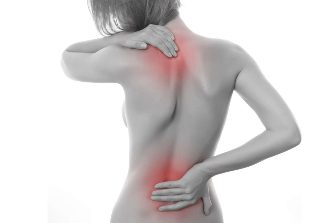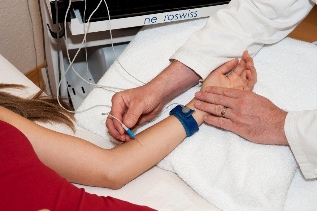Back pain - an unpleasant manifestation of many diseases or strong muscles for other reasons. In most cases, the abnormality occurs in the background of various changes in the structure of the joints of the spine and adjacent muscles, nerve endings, or the skin over the spine. In addition, such a symptom is accompanied by some disease or malfunction of internal organs.
The location of pain can tell a lot about what internal organs are damaged. Thus, pain in lower back suggests that may have hurt the bone of the spine, the person developing intervertebral hernia, the affected nerves, bone marrow, abdominal cavity and small pelvis.
Pain in the upper back is shown on the background of various diseases of the aorta, cancer or benign tumors in the chest, coughing, and also on the background of inflammation of the spine. But more often, back pain occurs due to large load on the joints and ligaments of the spine.
Etiology
Pain in the back is not uncommon for a perfectly healthy person, but several times more common in diseases. The main causes associated with disorders of the functioning of the body, are various violations of the integrity of the spine. This group of the pathological causes include the following diseases:
- osteomyelitis that affects the bone marrow;
- cancerous growths metastasize or spread to the spine, causing pain in the lower back;
- the education of hernias of intervertebral disks;
- the displacement of the vertebrae;
- spinal curvature of various degrees;
- fractures or other injuries of this organ;
- stenosis of the channels of the spine;
- spondylarthrosis - lesions of the cartilage;
- fibromyalgia is a chronic muscle pain that is accompanied by many unpleasant symptoms. There is not only pain in the upper back, but lower.
The main causes of back pain

The causes of pain, not associated with diseases of the spine or a change in its structure:
- pelvic bleeding;
- the compression of nerves in the sternum leads to back pain when inhaling;
- gynecological disease often characterized by unpleasant sensations in the right side or in the lower back in General;
- the accumulation of a large amount of blood in the retroperitoneal space;
- diseases of the various organs of small pelvis;
- an aortic dissection;
- peptic ulcer - causes pain in the back between the shoulder blades;
- disorders of kidney function;
- shingles;
- arthritis;
- disorders of the GASTROINTESTINAL tract and the genitourinary system cause back pain on the right or left (in place of the projection of the affected organ);
- malfunction of the organs localized in the abdominal cavity;
- rheumatological disease;
- tumors in the lungs will manifest pain when breathing or coughing;
- diseases of the cardiovascular system cause pain in the side, often the left;
- the formation of kidney stones, is manifested in low back pain;
- appendicitis - with this ailment, the pain gives to both sides
- infectious diseases, accompanied by damage to the lungs.
In most cases these reasons can cause back pain below the waist.
The factors due to which pain may occur in healthy adult or child:
- prolonged exposure to cold temperatures;
- the operating conditions under which a person is forced to lift weights for hours;
- sudden movement;
- with a strong cough (causes pain in back above waist);
- stay in an uncomfortable position, perhaps during sleep or during long journeys;
- the course of menstruation;
- injury or fractures, not necessarily spine. Due to fractures pain from damaged areas often radiates to the back;
- incorrect posture;
- increased body mass;
- age division - trouble with the back can occur at any age, but for people of middle and old age such a feature is a characteristic most often because the body may develop a chronic disease, slow down the process of what causes pain in the muscles of the back (may not pass a long time).
We should also consider a back pain during pregnancy. A woman during the whole period feels heaviness in the back, chest pain when you cough, is caused by the growing fetus and the pressure that it creates. Due to the displacement of the body, the muscles of the lower back and hip strain in order to support the weight. For these reasons, there is a pain in the back.
Varieties
Depending on the reasons for this uncomfortable feeling can be localized in different places:
- back pain above waist - may be intermittent or chronic nature, is mostly caused due to harmless factors, among which, improper organization of the workplace or lifting;
- pain in the lumbar - are shown on the background of displacement or herniation of intervertebral discs. The pain may be so severe that there is pain in back when breathing and coughing, but in a horizontal position all passes;
- the pain below the waist can occur due to hypothermia or severe back strain. If this symptom is apparent when it comes to any disease, you should immediately call an ambulance. For such a type is characterized by unpleasant sensations in the right side, which often give in the lower limbs;
- pain in shoulder blades - back pain on the left occurs when the heart attack or psychological problems. Often applies to such unusual places as the right arm, neck or groin. On the right side in the formation of stones or other kidney conditions. Pain directly in both blades expressed in tumors or tuberculosis;
- back pain on the right gives the signal of trouble breathing, pneumonia, or cancer of the lungs or bronchi, as well as the authorities involved in the urine;
- back pain on the left indicates a problem with the heart and respiratory system;
- pain in lower back - the most common form of discomfort, because it may be due to the large number of diseases, for example, when the catarrhal cough, or under the influence of external factors. Tellingly, if the pain spread to the side and continued for more than three months, this means that the disorder overflowed into the chronic form;
- pain in upper back - often become cancerous tumors or metastases in the lungs or spine.
Classification of back pain
Symptoms
Symptoms of back pain at various sites may vary, depending on causes. Most often pain in the back escorted by the following signs:
- the disability and motor function of a person due to the different intensity of pain and its extension in different directions, other organs or limbs;
- frequent urge to emission of urine, especially if the pain is caused by problems with the kidneys or urinary tract channel;
- in some cases there is fever;
- the sharp decline of body weight;
- diarrhea;
- weakness and pain in the muscles of the back;
- nausea, ending in vomiting;
- the pressure in the chest, heart and lungs;
- the appearance of a sharp pain in lungs when coughing;
- feeling short of breath;
- constant worry;
- absent-mindedness;
- the decrease in visual acuity and hearing.
Because the main symptom is pain, she can wear a different character. In some cases it can be acute and sharp, in others a constant and pressing. Often the pain spreads in different directions, internal organs or such places where in principle it should not be, for example, face, neck, lower jaw. In some cases a pain syndrome exacerbated after a meal, or, conversely, stops may occur during sleep due to improper position, or to complete, once a person takes a horizontal position.
Diagnosis
Before starting treatment, the therapist needs to conduct a series of surveys to determine possible causes of the expression of pain, its type and localization. To a doctor got the full picture about the course of this uncomfortable feeling, the patient needs:
Electromyography

- to provide complete information about symptoms that accompany the pain in the back, when they first appeared and how intense;
- to make a suggestion that could lead to such a feeling, for example, menstruation, uncomfortable posture for sleep or body position while working, coughing or sudden movements, and also to allow the specialist to see the full list of all the diseases of the particular patient over a lifetime;
- tell where the pain occurs, and what organs or body apply. It is very important to determine the diagnosis, because different localization of pain can talk about various diseases;
- pass a General examination in which the doctor performs palpation of the spine;
- tests of blood and urine to determine the pathological process or diseases of the kidneys;
- to perform x-rays - that will help to identify anomalies in the structure of the spine, thorax and lungs;
- go CT and MRI examination to detect possible pathologies of internal organs;
- to examine the muscle with an electromyography;
- to study the bone using the injection of a contrast agent. Where it will accumulate, and there is a breach;
- be examined to determine bone density;
- additionally, consult with such specialists as a neurologist, rheumatologist, orthopedist and vertebrologist.
After receiving all test results, the doctor will prescribe an individual treatment for each patient.
Treatment
If the pain is unbearable, before arrival of doctors it is necessary to implement measures for first aid:
- applying a cold compress to the back area, where localized pain;
- to ensure complete immobility to prevent further damage. The victim must take the most comfortable position of the body;
- to take pain medication;
- to eliminate any load.
After arriving in a medical institution treatment, is based on treatment of the underlying disease, which may consist of:
- anti-inflammatory drugs;
- warming ointments;
- drugs relieving spasm with intense pain in the lower back, as this type of pain is most common in patients;
- drugs, which will increase production of the components of cartilage tissue;
- physiotherapeutic treatment (heating);
- therapeutic massage;
- manual therapies, but they can be used only as directed by your doctor, because improper conduct such treatment is likely to worsen the situation;
- acupuncture - similar to the preceding paragraph is used with permission of the doctor;
- medical intervention - is it only in some cases, such as Oncology or installation required intervertebral prosthesis;
- wearing a special corset which will reduce the load on the spine and lower back.
Prevention
Preventive methods to prevent back pain are:
- timely treatment of major diseases of the spine, lungs, kidneys and abdominal organs;
- the rejection of heavy physical exertion and hypothermia of the body, especially in pregnant women;
- the observance of correct posture while working and training;
- providing a comfortable environment for sleep;
- correction of overweight;
- limiting sudden movements of the back;
- preventive examinations in the clinic for early detection of pathologies that cause back pain.

























